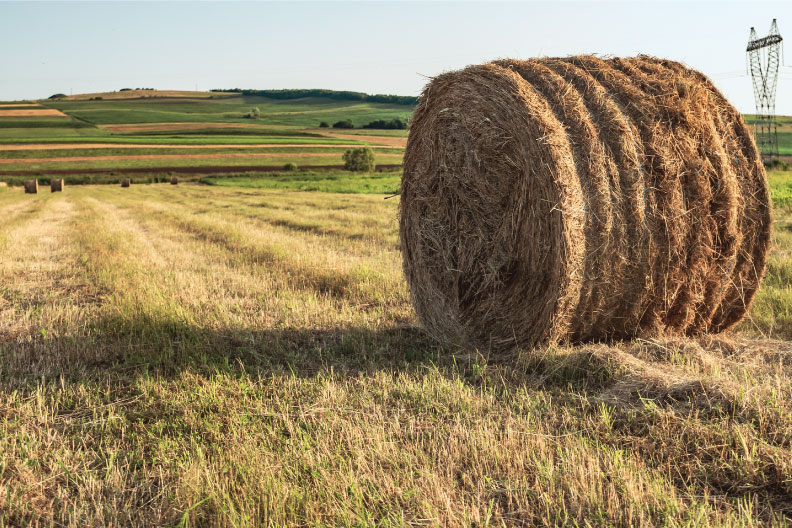Agri-Solve Inc.
Nitrogen deficiency in a corn crop is obvious. We have all seen the bottom leaves of a corn plant turn yellow prematurely and cringe knowing we just left 20-30+ bu/ac on the table. Most people can tell you what their target nitrogen rate is and roughly how many pounds of nitrogen are needed to make a bushel of grain. Planters are outfitted with dry fertilizer systems, manure is applied, maybe we Y-drop late season N and add a foliar. So why do we let our hay fields fend for themselves with little thought into the fertility program? I think the answer is that hay grows no matter and often our yield is so dependent on the weather, we think that yields are out of our control! We typically grow a few more acres than we need to, in order to ensure that we never run out. Some years we end up with “too much” and we tell ourselves we don’t really “need” the hay. The reality is that hay is, in fact, incredibly responsive to management. Besides, who doesn’t need an extra 20 ac available to grow $18 soybeans or $8 corn this year? So, let’s talk about managing hay fertility.
There are two important pieces of information that we need to know in order to determine if we are applying enough fertility to our hay fields. The first is estimated yield so that we can calculate crop removal. Per ton of dry matter, an alfalfa stand removes 12 lb/ac of phosphate and 49 lb/ ac of potassium (reference IPNI). For a 4.5 ton crop we are looking at 54 lb phosphate (P) and 220 lb potassium (K).
The second measure is any manure that is being applied. It is important to keep track of the application rate as well as to sample manure routinely to ensure an appropriate credit is given. On average, 1000 gal of liquid dairy manure applied in the spring will have approximately 12 lb available N, 5 lb available P, and 21 lb available K. If we do the math, we need approximately 10,000 gallons/ac per year of liquid dairy manure. For a larger barn with more wastewater, that could look closer to 12,000 gallons per year. If we break it down per cut, if hay fields are not getting a minimum of three applications of 3300 gal/ac each time, we are probably shortchanging the hay crop and depleting soil test levels.
No manure going on? No sweat. We can apply the balance of crop removal with commercial fertilizer. It takes 23 lb/ac of MAP and 82 lb/ac of potash fertilizer to replace what is taken out by one ton of dry matter.
With a yield of 4.5 ton/year, that is 104 lb MAP and 370 lb/ac of potash. Any combinations of manure and commercial fertilizer will work as long as we are not depleting the soil test! There are some situations where soil tests may be high and we can draw from them, however the vast majority of soil tests that I have seen on fields coming out of hay are low.
We’ve covered two of the key nutrients involved in hay production. The next two important nutrients are nitrogen (N) and Sulphur (S). We know that it is important to have nitrogen available to first cut stands with a grass component, but what about pure alfalfa stands and subsequent cuts? As we know, alfalfa fixes its own nitrogen. That said, in more recent years we have begun to see a response to Sulphur fertilizer in terms of yield and protein. Manure gives us a nice blend of nitrogen and Sulphur. If we do not have enough manure available, ammonium sulfate is a good option that is readily available in-season. The nitrogen component also gives the grass a boost in-season. If fall fertilizer is part of your program, elemental sulphur is a good, inexpensive option that should be available to the crop the following season. 25-50 lb/ac of actual S with these applications is a good target.
More frequent, lower volume applications are better than one or two large applications that could potentially smother the alfalfa. If field conditions allow, we ideally like to apply the first application in April, then subsequent applications after each cut. Although the first cut will contain more grass than subsequent cuts, our team has still found it beneficial to ensure that second and third cuts receive nitrogen and sulphur to encourage summer grass growth and protein in alfalfa. If you do not have access to manure, consider broadcasting ammonium sulfate after each cut as mentioned.
- Treat your hay like it’s a cash crop!
- Approximately 10,000 gal liquid dairy manure is required to
maintain soil test levels - Remember the importance of Sulphur
This article was written for the Summer 2022 Dairy Eastern Dairy Grist. To read the whole Dairy Grist, click the button below.

